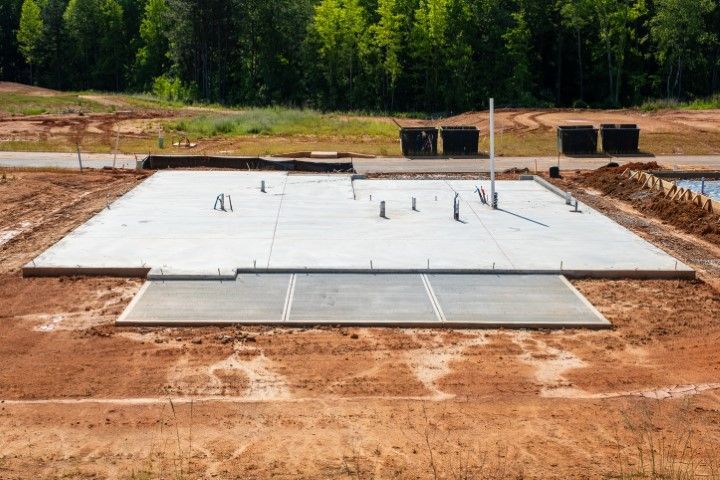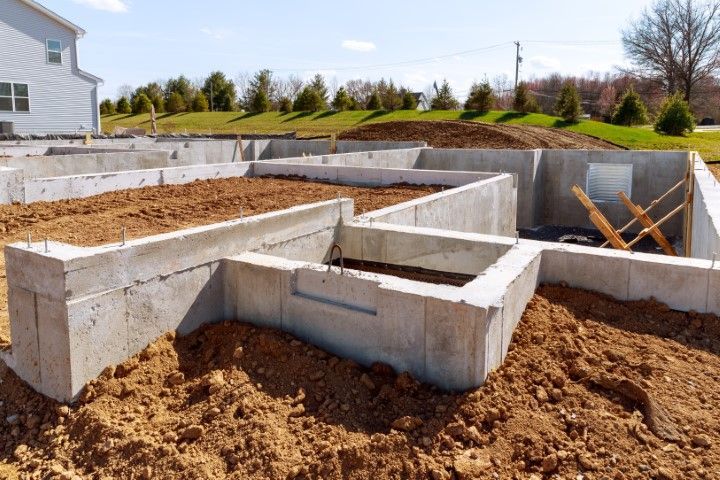Rock Solid Concrete Contractor
(513) 224-3364
Building a strong, lasting home or commercial space begins with a solid foundation. Weather and soil conditions can impact how your base is poured and cured. That’s why it’s important to work with professionals who understand the process from start to finish. Our team follows a careful approach to help ensure your foundation is built correctly, safely, and ready to support your structure for decades to come. Below, you’ll find an overview of our step-by-step process to pouring a foundation in Middletown, OH. Whether you’re planning a new home, an addition, or a commercial project, this guide can help you understand what to expect when you choose us for your project.
1. Site Preparation
First, we clear the area of any trees, rocks, debris, or old structures. Then, we level the ground and mark the boundaries where the foundation will go. Careful preparation helps avoid future problems, like uneven settling.
2. Excavation and Footings
Next, we dig to the required depth based on the size and type of building. After excavation, we create forms for the footings, which act as the base that spreads the weight of the building. We reinforce them with steel bars to add strength.
3. Formwork and Reinforcement
Once the footings are set, we build forms for the foundation walls. These forms hold the material in place as it cures. Before pouring, we install steel rebar inside the forms to make the walls stronger and more stable.
4. Pouring the Concrete Mixture
When everything is in place, it’s time to pour the concrete. We work quickly and carefully to fill the forms and remove air pockets. A smooth, even pour is essential to achieve the best results. Our crew uses tools to level and finish the surface.
5. Curing the Foundation
Proper curing is critical. We keep the poured material moist for several days to help it gain strength. This step prevents cracking and ensures the foundation reaches its full durability. The curing process can take about a week, depending on temperature and humidity.
6. Removing the Forms
Once curing is complete, we remove the forms around the walls. At this stage, you’ll see the final shape of the foundation. We inspect every inch to confirm it meets all quality and safety standards.
7. Backfilling and Site Cleanup
The last step involves filling the area around the foundation with soil and gravel. This protects the walls and creates proper drainage. After backfilling, we clean up the site so it’s ready for the next stage of construction.
If you’re planning to build, our team is here to help you create a foundation you can trust. We take pride in clear communication and dependable service. From your first call to the final inspection, we’ll guide you through each phase. To get started or to ask questions about your upcoming project, contact us today. We’d be happy to provide a free estimate and answer any concerns you may have about your new concrete foundation.
Get a No-Obligation Quote Today

Types of Concrete Foundations and Their Uses
When building any structure, the foundation is one of the most important parts to get right. A strong foundation supports the entire building and keeps it safe over time. Choosing the right type of foundation depends on many factors, such as the soil, climate, and the weight of the building. This guide will explain some common types of concrete foundations and how they are used in different projects. Whether you are planning to build a home, a garage, or a large commercial space, understanding your options can help you make the best decision.
Slab-on-Grade Foundation
The slab-on-grade foundation is a single layer of concrete poured directly onto the ground. This type of foundation is often used in warmer climates where the ground does not freeze. It is simple and cost-effective, making it a popular choice for homes and small buildings. The slab provides a flat, sturdy surface for flooring and helps keep moisture out. However, it may not be suitable for areas that experience heavy frost.
Crawl Space Foundation
A crawl space foundation lifts the structure slightly off the ground. It uses short walls, called stem walls, to create a space under the building. This design allows for easier access to plumbing and electrical systems. It also helps keep the floors warmer in cold weather. Crawl spaces are often used in regions where the soil can become damp or where ventilation is needed under the house.
Basement Foundation
Basement foundations are deeper than other types. They create a full room or storage space beneath the main floor. Basements are common in colder regions because the foundation extends below the frost line, which prevents damage from freezing. They can also add valuable living or storage space to a property. However, building a basement usually costs more due to extra excavation and waterproofing.
Pier and Beam Foundation
A pier and beam foundation uses concrete piers or wooden posts set deep into the ground to hold up the building. Beams then span across the piers to support the structure above. This method is often used when the soil is unstable or when building on slopes. It allows for ventilation and easy access to utilities under the building. Pier and beam foundations can be adjusted if the ground shifts, which helps prevent long-term damage.
T-Shaped Foundation
The T-shaped foundation is a traditional choice for areas with cold winters. It involves building a footing below the frost line, then adding walls on top of it, and finally pouring the slab. The shape of the footing helps spread the weight and keeps the foundation steady. This type is often used for heavy buildings that need strong support.
Choosing the right foundation is not always simple. It depends on the location, size of the project, and the soil conditions. If you are planning a building project and want professional advice, our team is here to help. We can guide you through every step, from design to construction, to make sure you get a solid base that lasts for many years. Feel free to contact us today to discuss your needs or ask any questions about your options. We look forward to working with you to build something strong and reliable.

Foundation Waterproofing: Why It Matters
Your home is one of the biggest investments you will ever make. Keeping it safe, dry, and strong should always be a priority. One way to protect your home is by making sure your foundation stays free of moisture. Many people think about roof leaks or plumbing problems, but forget about what happens below ground. Foundation waterproofing is an essential step that helps prevent damage that you may not see right away but could cost you a lot over time.
Stops Water Damage Before It Starts
When water seeps into your foundation, it can slowly break down the materials that hold your home together. Over time, moisture can erode surfaces, weaken support walls, and cause cracks to spread. Once cracks form, water finds its way inside more easily. By waterproofing your foundation, you can stop this cycle before it begins. Keeping water out will help maintain the strength of your concrete walls and keep your basement dry.
Prevents Mold and Mildew
Damp basements are the perfect environment for mold and mildew to grow. These fungi do more than make your home smell musty—they can also harm your health. Mold releases tiny spores into the air, which can lead to breathing issues, headaches, and allergic reactions. Waterproofing your foundation helps reduce humidity and moisture levels, making it much harder for mold to take hold. In the long run, this creates a cleaner and safer space for you and your family.
Protects Your Property Value
A home with a dry, solid foundation is worth more than one with visible water problems. Buyers today often look for signs of leaks or moisture before making an offer. Even a small water stain on the basement walls can raise concerns and lower the price of your home. By investing in foundation waterproofing, you show future buyers that you took good care of the property. This can help you sell faster and get a better return on your investment.
Gives You Peace of Mind
There’s something comforting about knowing that your foundation is protected. Heavy rainstorms, melting snow, or rising groundwater won’t be as stressful when you know your home has been properly waterproofed. You can use your basement for storage, work, or play without worrying about dampness ruining your belongings. When your foundation stays dry and strong, you can relax and enjoy your home without fear of hidden damage.
If you want to learn more about foundation waterproofing or need help with your
stamped concrete patio, we are here to assist you. Our experienced team can inspect your property and recommend the best solutions for keeping moisture out. Whether you have an old home with existing leaks or a new build that you want to protect, we can help you safeguard your investment. Reach out to us today to schedule an assessment or to ask any questions. Together, we can keep your concrete foundation strong and your living space dry for years to come.